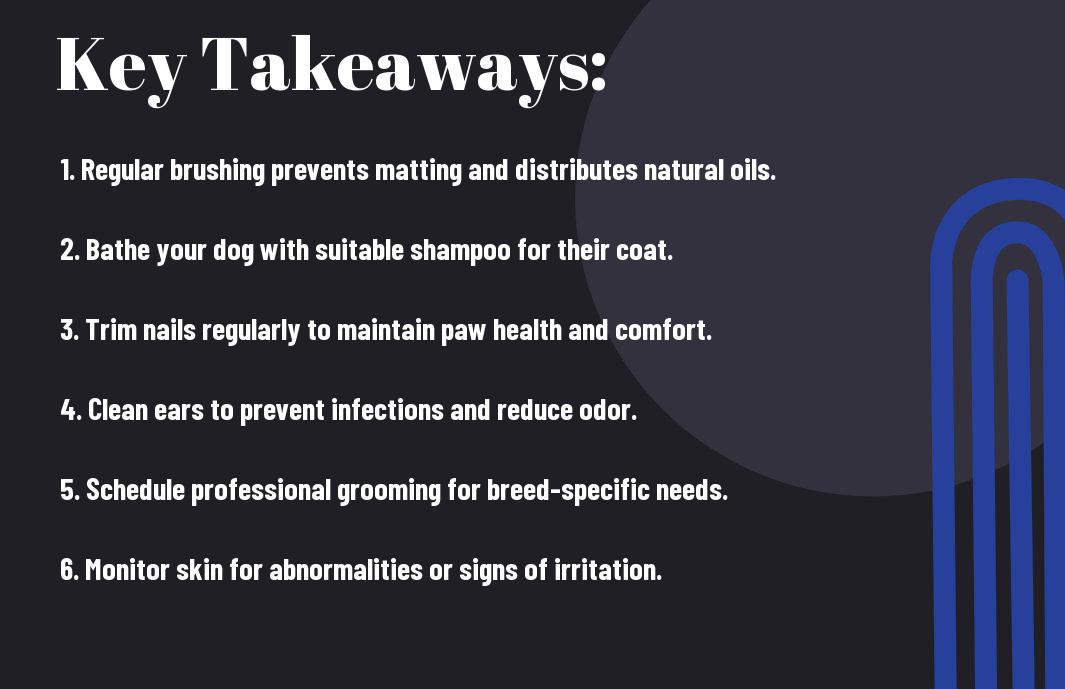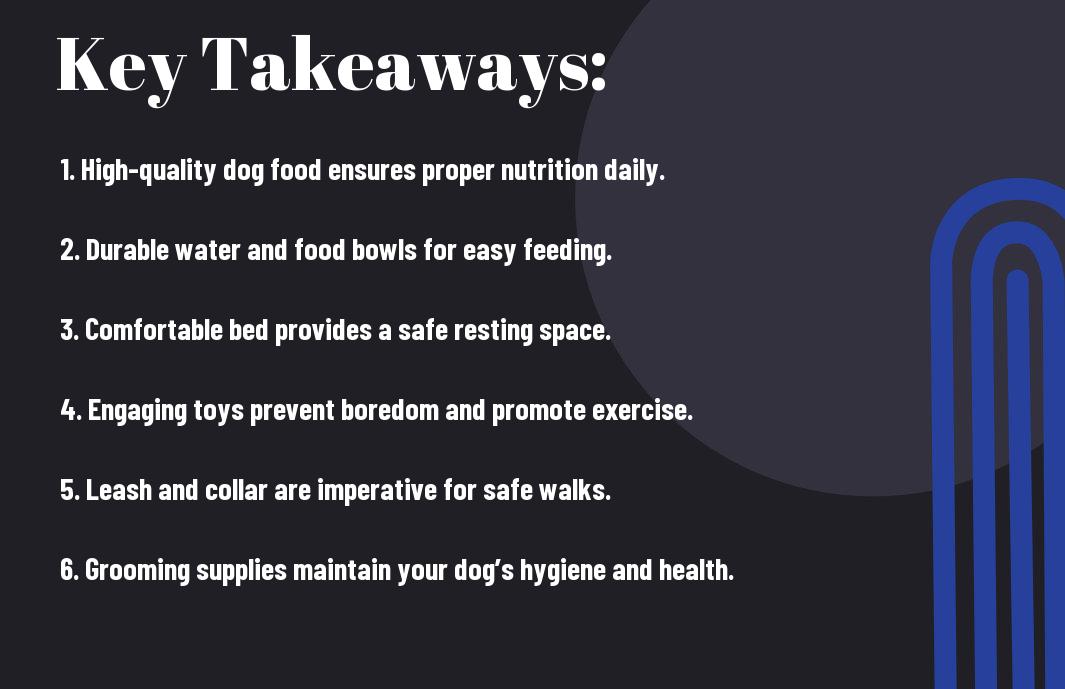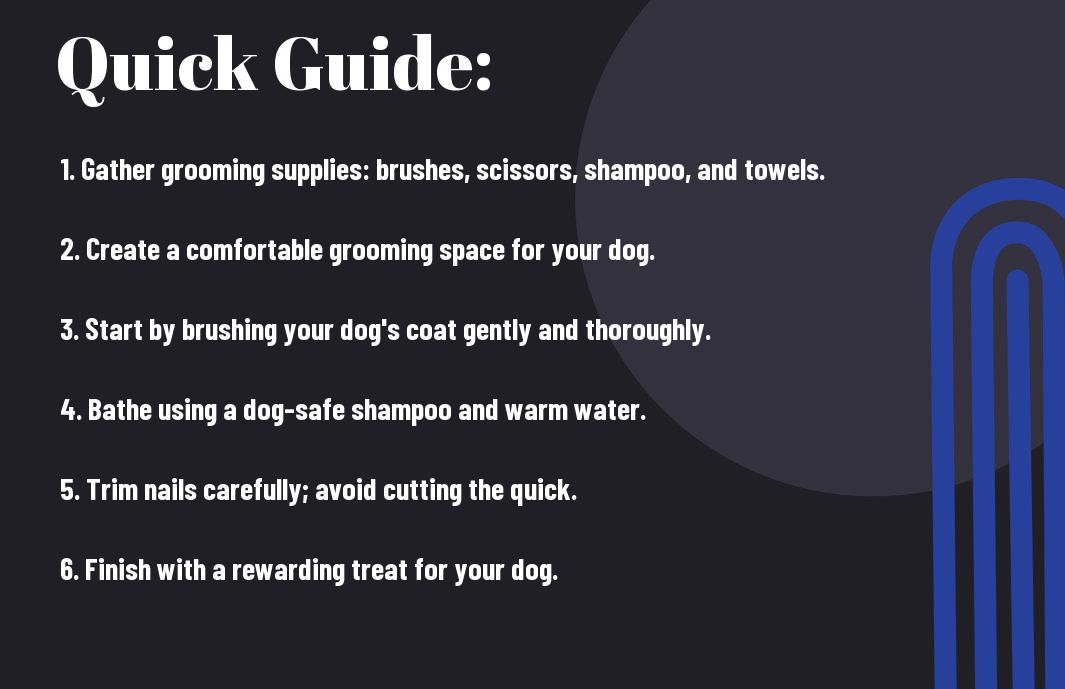Over time, proper grooming becomes important for maintaining your dog’s coat, ensuring it stays healthy and clean. Not only does regular grooming help prevent matting and tangles, but it also plays a significant role in managing skin issues and parasites. In this blog post, you will learn about the tools and techniques necessary to keep your furry friend looking their best, allowing you to enjoy a happier and healthier relationship with your pet.


The Importance of Grooming
A grooming routine is not just about aesthetics; it serves multiple purposes that benefit both you and your furry companion. Regular grooming helps to maintain your dog’s coat and skin health, minimizing the risk of infections and skin issues. A well-groomed dog is less prone to matting, shedding, and related irritations, allowing them to feel more comfortable as they go about their day. Additionally, grooming provides an excellent opportunity for you to check for any irregularities, such as lumps or parasites, that may be hidden beneath their coat.
Health Benefits of Regular Grooming
Above all, regular grooming contributes significantly to your dog’s overall health and well-being. By brushing your dog’s coat, you help to distribute natural oils, promoting a shinier and healthier coat. This process also eliminates dirt and debris, which can harbor harmful bacteria. Moreover, consistent grooming sessions lead to better circulation in your dog’s skin, enhancing their comfort and vitality.
Additionally, grooming can help prevent issues like hot spots—areas of inflamed skin that can become infected due to fur matting and moisture retention. By staying on top of grooming, you’re not only ensuring a clean and healthy coat but also reducing the chances of discomfort for your dog, allowing them to thrive.
Psychological Effects on Your Dog
Across breeds and temperaments, grooming plays an imperative role in your dog’s mental health. Dogs are social animals that thrive on routine and connection. Regular grooming sessions can create a calming atmosphere, helping your dog feel more at ease and comfortable around you. This familiarity reduces stress and anxiety, enhancing your dog’s overall mood and happiness.
In fact, many dogs come to enjoy the grooming process, viewing it as a bonding time with you. The gentle touch of brushing and positive reinforcement during grooming can foster trust and security, making your dog feel cherished. Additionally, a relaxed grooming experience can stimulate their mind, providing them with the mental engagement they need alongside their physical health benefits.
Building a Bond Through Grooming
Around the grooming experience, you have an incredible opportunity to strengthen the bond between you and your dog. Taking the time to carefully groom your dog allows you to engage in meaningful interactions that can significantly enhance your relationship. Every brushstroke can be a moment of connection, ensuring your dog feels loved and taken care of while you work together on their grooming needs.
Through grooming, you are not only maintaining your dog’s coat but also reinforcing your role as a caregiver. This can lead to increased trust and affection between you and your dog, making future grooming sessions even smoother. It’s imperative to approach these moments with patience and love, providing your dog with the best reassurance they need to feel safe and secure in your presence.
Understanding Your Dog’s Coat Type
Now that you have started your journey toward maintaining a healthy and clean coat for your dog, it’s crucial to understand the distinct types of coats that different breeds possess. This understanding will make it easier for you to choose the right grooming techniques and products. The types of coats can affect how often you need to groom your dog, what tools you should use, and what specific care your dog will require. By knowing your dog’s coat type, you can ensure that their grooming routine is tailored perfectly to fit their needs.
Different Coat Types: A Comprehensive Guide
Before you investigate grooming, it’s important to identify the type of coat your dog has. Below is a table that outlines five common coat types along with their specific characteristics and grooming needs:
| Coat Type | Characteristics |
|---|---|
| Short Coat | Requires minimal grooming; less prone to matting. |
| Medium Coat | Mild grooming needed; may shed seasonally. |
| Long Coat | Frequent grooming required to prevent tangles. |
| Curly Coat | Low to moderate shedding; needs regular grooming. |
| Wire Coat | Unique texture; requires stripping and professional grooming. |
Assume that you have identified your dog’s coat type accurately, as this will guide you in crafting an effective grooming plan tailored to your dog’s requirements.
Determining Grooming Needs Based on Coat Type
After understanding the different coat types, the next step is determining the grooming needs based on the specific characteristics your dog’s coat presents. Each coat type requires a different approach to care. For instance, a long-haired dog may require daily brushing to prevent tangles and mats, while a short-coated dog may only need a weekly brushing routine. Additionally, your dog’s activity level, age, and health can also influence their grooming needs.
Understanding your dog’s grooming requirements is crucial for their overall health. For example, neglecting grooming for a long-coated breed can lead to painful tangles, skin infections, and discomfort. Matching your grooming routine to your dog’s coat type will not only keep them looking their best but will also enhance their overall well-being.
Seasonal Changes and Their Impact on Grooming
Beside recognizing your dog’s coat type, it is important to consider how seasonal changes can affect your grooming routine. Many dogs will shed their undercoat as the weather warms up, which can lead to increased grooming needs in spring and summer. Similarly, in winter, some dogs may need more attention to their coat to prevent matting from moisture or snow. Adjusting your grooming schedule based on the season can help maintain a healthy coat and minimize shedding.
To facilitate optimal hair health, keep an eye on your dog during major seasonal changes. You may need to change your grooming tools or add specific products to manage the effects of weather on your dog’s coat type. Pay special attention to any signs of discomfort or changes in your dog’s skin condition, as this can indicate that it’s time to adjust your grooming strategies.
Essential Grooming Tools
For maintaining your dog’s coat in optimal condition, having the right grooming tools is imperative. Effective grooming not only enhances the appearance of your pet but also contributes to their overall health and well-being. Investing in high-quality tools will lead to better grooming experiences for both you and your furry friend.
Brushes and Combs
Above all, brushes and combs are fundamental to your grooming toolkit. They help remove loose hair, dirt, and debris, while also distributing natural oils throughout your dog’s coat, keeping it shiny and healthy. Choosing the right type of brush depends on your dog’s coat type; long-haired breeds may require a slicker brush, while short-haired breeds benefit from a bristle brush.
Above and beyond cleanliness, regular brushing helps prevent matting and tangles. Combing should be integrated into your routine, particularly for dogs with longer hair. A wide-toothed comb works well for detangling, while a fine-toothed comb is ideal for finishing touches. The right brushes and combs can make the grooming process enjoyable for your dog and effective for you.
Clippers and Shears
Above the basics of brushing, you’ll want to consider clippers and shears for more specific grooming needs. These tools are imperative for trims and managing the length of your dog’s coat, especially for breeds that require regular grooming to stay neat. When choosing clippers, look for models designed for pet grooming to ensure effective results without stressing your dog.
Above all, proper technique in using clippers and shears is necessary to avoid cuts and discomfort. Watch instructional videos if you’re uncertain of the best practices. With patience and practice, you’ll be able to provide your furry friend with stylish cuts while keeping them comfortable throughout the process.
A reliable pair of clippers and shears can make a significant difference in your grooming endeavors. Maintaining the right blade length for your dog’s specific breed helps prevent overheating during the grooming session and minimizes any risk of injury. Investing in quality tools will pay off in the long run.
Bathing Supplies
Against the backdrop of good grooming practices, bathing supplies come into play to aid in keeping your dog clean. Dog shampoos, conditioners, and towels are imperative components of your toolkit for a successful bath. Moreover, choosing a dog-specific shampoo tailored to your pet’s coat type is vital to avoid skin irritation caused by human products.
Against common misconceptions, not every dog needs frequent baths. Bathing too often can strip natural oils, leading to dry skin, while under-bathing can lead to odor and skin issues. Assess your dog’s coat and activity level to determine the appropriate bathing frequency.
Further, consider using a rubber massage brush during bath time, as it can help distribute shampoo evenly while stimulating your dog’s skin. This makes the bathing process enjoyable while promoting a healthy coat.
Nail Care Tools
Bathing your dog is just the beginning of comprehensive grooming; nail care tools play an imperative role too. Nail clippers and grinders help maintain your dog’s nails at a safe length, preventing painful breaking or snagging. It’s important to choose clippers suitable for the size of your dog to ensure a clean cut.
Bathing isn’t complete without addressing your dog’s nails, which can contribute to a well-groomed appearance and overall comfort. Additionally, nails that are not clipped properly can lead to joint pain and mobility issues over time.
But regular nail maintenance is not just about aesthetics; it directly impacts your dog’s health. Keeping nails trimmed also means safer playtime and walks, reducing the risk of injuries and promoting proper gait. Incorporating nail care into your grooming routine can enhance your dog’s quality of life.
Ear and Eye Care Products
Beside the coat and nails, paying attention to your dog’s ears and eyes is imperative for their overall health. Regular cleaning can help prevent infections and other complications. Use dog-specific ear cleaners and wipes designed for gentle use around the eyes to maintain cleanliness without causing discomfort.
Beside the physical aspect, this kind of care also provides an opportunity for bonding, as many dogs enjoy the gentle attention that comes with ear and eye care. Establishing a routine for these checks can help you detect any issues early on, allowing for prompt intervention when necessary.
Plus, proper ear and eye care contributes significantly to your dog’s well-being. Make it a point to integrate ear cleanings and eye wipes into your grooming sessions; this practice not only keeps your canine companion looking their best but also guards against health problems that can arise from neglect.
The Grooming Process
Not every grooming session is the same, so it’s crucial to understand the different techniques and processes involved in keeping your dog’s coat healthy and clean. Establishing a routine will not only benefit your dog’s appearance but also their overall health. Below is a breakdown of various grooming methods tailored to your dog’s specific needs.
Brushing Techniques for Different Coat Types
Below is a simple guide to help you choose appropriate brushing techniques based on your dog’s coat type:
| Coat Type | Brushing Technique |
| Short Hair | Use a bristle brush or grooming glove to remove loose hair. |
| Medium Hair | Use a slicker brush followed by a comb to detangle. |
| Long Hair | Start with a wide-toothed comb and follow with a pin brush. |
| Curly Hair | Use a comb or specific curly-haired dog brush to avoid breakage. |
| Wire Hair | Use a stripping knife or coarse brush to maintain the texture. |
This table gives you a clear understanding of how to properly manage your dog’s coat, ensuring they remain comfortable and well-groomed.
Bathing: Frequency and Techniques
One of the crucial aspects of dog grooming is determining the right time to bathe your dog. Different breeds and coat types dictate the bathing frequency; generally, it ranges from every few weeks for active dogs to only several times a year for those with drier skin. Always use dog-specific shampoos to avoid skin irritation.
To bathe your dog effectively, start by brushing them to remove any tangles. This helps in achieving a more thorough clean. Use lukewarm water and ensure your dog is comfortable throughout the process. Pay attention to areas that accumulate dirt, such as under the paws and behind the ears.
At the conclusion of the bath, be on the lookout for any signs of skin issues such as redness or irritation that may need veterinary attention. Following the bath, apply a suitable conditioner recommended for your dog’s coat type to keep it hydrated and easier to manage.
Drying Your Dog: Best Practices
Process matters when it comes to drying your dog after a bath. Using a towel to gently pat down your dog is an effective initial step. Avoid vigorous rubbing as it can tangle and damage their coat. For dogs who aren’t fearful of noise, a low-setting blow dryer can be useful, but be sure to keep it at a safe distance.
Another option is to let your dog air dry in a warm area, ensuring they are supervised to prevent them from rolling in dirt or water after their clean bath. Giving them a cozy blanket can also help keep them warm as they dry.
Nail Trimming: Safe and Effective Methods
Practices around nail trimming can greatly affect your dog’s comfort and mobility. Regular trimming is important, as overgrown nails can lead to discomfort and even injury. It’s best to keep a pair of clippers specifically designed for pet nails, along with some styptic powder in case you accidentally cut too close to the quick.
Types of clippers vary; some owners prefer electric grinders that soften the nail tip, while others stick to traditional guillotine-style clippers. Choose what you feel most comfortable using, and consider your dog’s temperament when selecting the method.
Cleaning Ears and Eyes
Cleaning your dog’s ears and eyes is an often-overlooked aspect of grooming. Cleaning regularly can help you avoid ear infections and eye issues caused by debris and bacteria build-up. Always use appropriate solutions meant for dogs; never use cotton swabs, which can push debris further in.
Techniques for ear cleaning involve gently wiping the outer ear with a cotton ball dampened with an ear-cleaning solution that is safe for dogs. For eye care, aim to softly clean around the eyes with a damp cloth to remove tear stains. Maintain a consistent schedule, and you’ll keep your dog feeling fresh.
Addressing Common Coat Issues
All dog owners must be prepared to tackle common coat issues that can affect their furry friends. These concerns not only impact the appearance of your dog’s coat but can also indicate underlying health problems. When you take proactive steps to address these issues, you can ensure that your dog maintains a healthy and vibrant coat throughout their life.
Matting: Prevention and Solutions
Issues such as matting can be painful for your dog and make grooming a challenging task. Matting occurs when your dog’s fur tangles and knots, creating clumps that are difficult to remove. Preventing matting starts with regular grooming sessions, ensuring you brush your dog’s coat at least once a week, or more frequently for long-haired breeds. Using the right grooming tools, such as wide-toothed combs for detangling, can help you keep your dog’s coat smooth and free from knots.
When mats do occur, it is important to tackle them gently. You can begin by using a mat splitter or slicker brush to slowly work through the tangles without causing pain to your dog. In severe cases, where matting is extensive, it may be necessary to seek professional grooming services to safely remove the mats without hurting your dog’s skin.
Shedding: Understanding and Managing
Any dog owner knows that shedding can be a significant part of life with your pet. Different breeds shed at varying rates, and understanding your dog’s shedding patterns is key to effective management. Regular brushing removes loose fur and helps minimize the hair that ends up on your clothes and furniture. Additionally, maintaining a balanced diet rich in omega fatty acids can also promote a healthier coat that may shed less.
Indeed, managing your dog’s shedding is achievable with the right strategies. By using specialized grooming tools such as de-shedding brushes or grooming gloves, you can effectively minimize the amount of loose fur in your home. Also, maintaining a regular grooming schedule will help you keep shedding under control and your dog comfortable.
Skin Conditions: Identification and Care
Coat health is often closely tied to your dog’s skin condition. Various skin issues, such as dryness, hot spots, or fungal infections, can lead to an unhealthy-looking coat. It’s crucial to regularly inspect your dog’s skin, looking for signs of irritation, redness, or unusual odors. Identifying any skin conditions early is vital for effective treatment and for keeping your dog comfortable.
To ensure optimal care for your dog’s skin, consider using veterinarian-recommended shampoos and conditioners that contain soothing ingredients. Regular baths—using appropriate products for your dog’s specific skin type—can also help maintain a healthy coat. If you notice persistent skin problems or worsening symptoms, it is advisable to consult with your vet for tailored treatment options.
Allergies: Recognizing Symptoms and Treatments
Matting can be exacerbated by allergies that cause your dog to scratch excessively, leading to inflammation and further coat damage. Allergies may manifest through symptoms such as excessive scratching, biting at the skin, or even watery eyes. Recognizing these symptoms early can help you address the source of the allergy effectively, whether it be environmental factors like pollen or specific food ingredients.
With proper identification, treatment can involve a combination of antihistamines, topical treatments, and, in some cases, dietary changes. Depending on the severity of the allergy, working with your veterinarian is vital to establish a comprehensive care plan that supports your dog’s health and comfort.
Grooming Specific Breeds
To effectively groom your dog, it’s vital to understand the specific needs of their breed. Different breeds come with unique grooming requirements that cater to their coat type, skin sensitivities, and overall health. This knowledge not only helps maintain your dog’s appearance but also ensures their comfort and hygiene. Whether your furry friend has a long, flowing coat or a short, sleek one, knowing the best practices for grooming will enhance their coat’s vitality and cleanliness.
Grooming Strategies for Long-Haired Breeds
For your long-haired dog, frequent grooming is a necessity to prevent mats and tangles. Ideally, you should brush your pet’s coat at least two to three times a week, if not daily. Start by using a wide-toothed comb to gently detangle any knots, and then follow up with a slicker brush to smooth the coat. Don’t forget to pay extra attention to areas behind the ears and under the legs, as these spots are more prone to matting. A bath every few months, along with regular trimming, will keep your long-haired dog’s coat manageable and healthy.
For some breeds, it might be beneficial to incorporate professional grooming into your routine. A groomer can help maintain their coat length, style, and overall health while ensuring your dog feels comfortable throughout the process. Make it a positive experience by introducing your dog to the grooming tools gradually, and follow up each session with a treat to reinforce good behavior.
Grooming Needs of Short-Haired Breeds
Grooming short-haired breeds may seem simpler, but they too require specific attention to keep their coats looking good and to maintain skin health. Regular brushing, about once a week, is recommended to remove loose hairs and help distribute natural oils throughout the coat. Use a bristle brush or a rubber curry brush for best results. Bathing should be performed as needed, ensuring you use a gentle shampoo specifically formulated for dogs.
And even though short-haired breeds are less prone to matting, you should still keep an eye on areas like the ears and paws, where dirt and debris can accumulate. Regular check-ups for ear cleaning and nail trimming are also vital to ensure your dog remains comfortable and their coat stays in optimal condition.
Special Considerations for Hypoallergenic Breeds
Grooming hypoallergenic breeds requires you to focus on minimizing allergens while ensuring their coat remains healthy. Since these dogs tend to shed less dander and fur, you might find that routine grooming includes not only brushing but also bathing them more frequently, usually every four to six weeks. Make sure you utilize products that are gentle on their skin, as hypoallergenic breeds may also be sensitive to certain ingredients.
Special grooming tools, like special combs for their unique coat texture, can enhance their grooming experience. Keeping your living environment clean will also contribute to reducing allergens, so regularly wash their bedding and spaces they frequent.
Grooming the Senior Dog: Adjustments Needed
Below the surface, grooming your senior dog involves more than just addressing coat care; it requires an awareness of their changing needs. As dogs age, they may develop weaker skin, reduced mobility, and other health concerns that necessitate gentle handling. You might want to adjust your grooming schedule, opting for shorter, more frequent sessions that cater to their comfort level while still addressing their grooming needs.
Additionally, consider using tools designed for sensitive skin, such as soft brushes or special grooming gloves that provide a gentle touch. Ensuring your senior dog remains comfortable throughout the grooming process is paramount, and always be attentive to signs of fatigue or discomfort.
Another important aspect of caring for senior dogs is to keep an open line of communication with your veterinarian. They can provide insight into any health changes that may impact your grooming routine and recommend the best approaches to ensure your senior dog’s grooming experience is both pleasant and beneficial to their health.

Professional Grooming vs. DIY Grooming
Keep in mind that grooming is imperative for your dog’s health and well-being. You have two primary options: seeking professional grooming services or handling grooming on your own. Both methods have their unique benefits and challenges, so understanding when to choose between them can help you make the best decision for your furry friend.
When to Seek Professional Help
At times, your dog may require special treatments or grooming techniques that are best handled by a professional groomer. For example, breeds with intricate cutting and styling needs, like poodles or Yorkshire terriers, may require expert attention to maintain their coats properly. If your dog has matted fur or skin issues, it may be safer to consult a professional who has the right tools and knowledge to address these conditions effectively.
Additionally, if you feel uncertain about how to groom your dog safely or efficiently, professional grooming services can offer peace of mind. Many professional groomers also provide treatments like nail trimming, ear cleaning, and teeth brushing, which you may find daunting to complete on your own. Deciding to seek help can ultimately create a better grooming experience for both you and your dog.
Benefits of Professional Grooming Services
By opting for professional grooming services, you can gain access to experienced groomers who are trained to handle various breeds and temperaments. They know how to use grooming tools correctly and efficiently, allowing your dog to receive a thorough and comfortable grooming session. Furthermore, professionals often have access to high-quality products that can enhance the health and appearance of your dog’s coat.
In addition to the technical skills they possess, professional groomers can spot early signs of health issues, such as skin infections or parasites. These early detections can ultimately save you money on veterinary bills and enhance your dog’s quality of life. Ultimately, investing in professional grooming services can lead to a happier and healthier pet.
And don’t forget that regular grooming can significantly reduce shedding and allergens in your home. Maintaining your dog’s coat with professional help can save you time and effort, ensuring that the job is done right each session.
DIY Grooming Tips for Pet Owners
Behind every great grooming session at home, there are some imperative tips to follow. Regular brushing is key to keeping your dog’s coat healthy and free of mats. Be sure to choose the right grooming tools based on your dog’s breed and coat type. You can follow these basic DIY grooming tips:
- Use a high-quality brush suitable for your dog’s coat type.
- Establish a routine to brush your dog at least once a week.
- Trim your dog’s nails carefully to prevent overgrowth.
- Be mindful of your dog’s skin health and watch for irritations.
The more you groom your dog at home, the more comfortable it will become with the process.
For instance, creating a simple grooming station in your home can significantly improve your efficiency. Make sure you have all your grooming tools organized and accessible. Some key items to have handy include:
- A high-quality dog shampoo for bathing.
- Various sizes of grooming clippers for different coat lengths.
- A comb and brush specifically suited for your dog’s fur type.
- Dog-friendly hydrating sprays for coat maintenance.
The more prepared you are, the smoother the grooming experience will be for both you and your pet.
Cost Considerations and Budgeting for Grooming
Beside the practical aspects of grooming, consider the financial implications associated with both professional and DIY grooming. A professional groomer’s services may vary in cost depending on your dog’s breed, size, and coat condition. Some services may include extra fees for add-ons like flea treatments or specialized haircuts. On the other side, grooming at home requires an initial investment in quality grooming tools and products, but allows you to save money in the long run.
Additionally, think about how often your dog needs to be groomed and factor those sessions into your budget. If you maintain a regular grooming schedule at home, you might only need to take your pet for professional grooming occasionally, striking the right balance between the two methods.
Seek to evaluate your pet’s specific grooming needs carefully and consider your ability to meet those needs through DIY efforts or by engaging professionals. This thoughtful approach will help you budget effectively and ensure your dog always looks and feels its best.
Conclusion
So, maintaining your dog’s coat is not just about aesthetics; it plays a vital role in their overall health and well-being. By incorporating regular grooming practices into your routine, you can effectively reduce shedding, prevent matting, and keep your dog’s skin healthy. Tools such as brushes, combs, and quality shampoos tailored for your dog’s coat type will enhance the grooming experience both for you and your furry companion. Additionally, staying attentive to your dog’s grooming needs throughout the year will help you address any issues before they become problematic.
Furthermore, grooming sessions can also serve as a bonding opportunity between you and your dog, fostering trust and comfort. By embracing the imperative grooming practices discussed, you ensure that your dog not only looks their best but also feels their best. A well-groomed dog is happier, more confident, and less prone to skin problems, contributing to a healthier, active life that you can cherish together.
FAQ
Q: What are the basic grooming importants needed for maintaining my dog’s coat?
A: To keep your dog’s coat healthy and clean, you’ll need a few key grooming tools. These include a high-quality brush suitable for your dog’s coat type (such as a slicker brush for long-haired breeds or a bristle brush for short-haired dogs), a comb for detangling, dog shampoo that matches their skin sensitivity, conditioner to keep the coat soft, and nail clippers or grinders for paw care. Additionally, ear cleaning solution and a toothbrush designed for dogs can be beneficial for overall hygiene.
Q: How often should I groom my dog to keep their coat in good condition?
A: The frequency of grooming largely depends on your dog’s breed, coat type, and lifestyle. Short-haired breeds may only require grooming once a week, while long-haired or curly breeds may need grooming several times a week to prevent mats and tangles. Regular grooming not only helps keep the coat clean but also promotes healthy skin through the distribution of natural oils. Always keep an eye on your dog’s coat condition and adapt your grooming schedule as needed.
Q: What are the signs that my dog’s coat needs more attention?
A: There are several indicators that suggest your dog’s coat may require additional grooming. Look for excessive shedding or matting, which may indicate that it’s time to brush more frequently. Also, check for dullness, as a healthy coat should have a natural shine. If your dog is frequently scratching or appears to have skin irritations, it might be due to an unkempt coat. Additionally, if you notice an unpleasant odor, it could be a sign that a bath is overdue. Staying vigilant about your dog’s grooming needs is important for their overall health.










